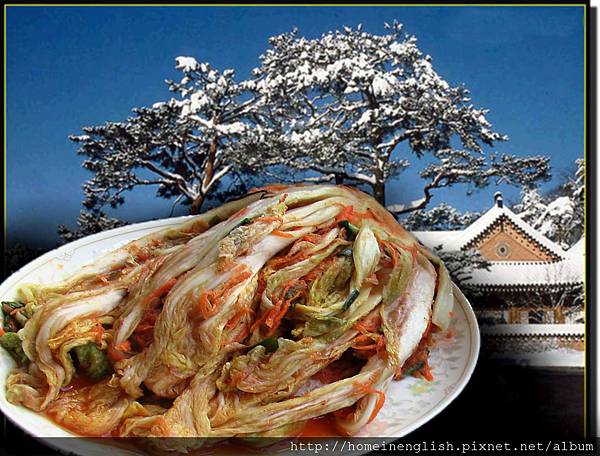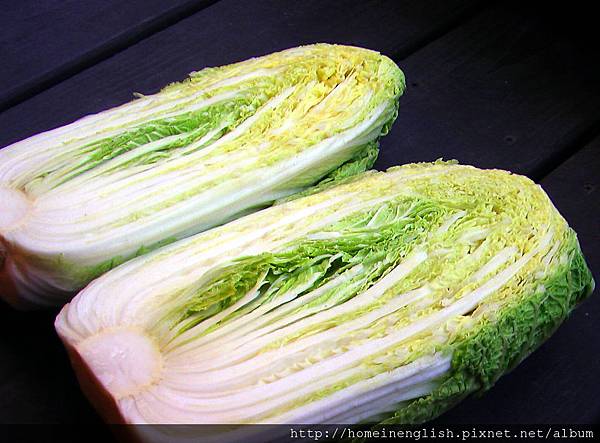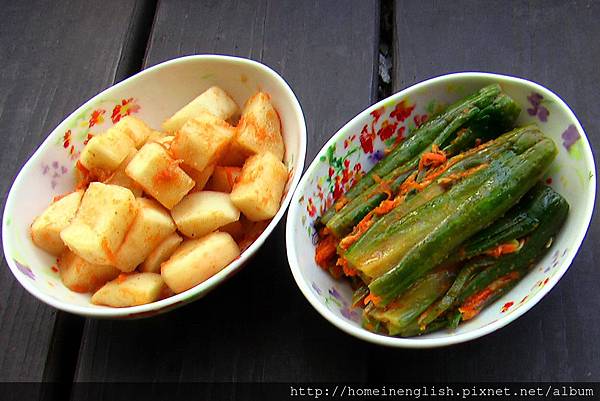Kimchi is made from vegetable that has been preserved in salt water. We have learned a long time ago that harmful microbes can’t survive in an environment with 5 – 10% salt. However, yeast and lactobacillus can still thrive in this condition and ferment to produce alcohol and lactic acid. Kimchi gets its flavors from this fermentation process and is able to be kept for a long time for the same reason.
Szechuan kimchi and Korean kimchi are two famous representatives in the kimchi world. People may feel that Korean and Szechuan kimchi have nothing alike. This misconception is formed because most of us are only exposed to Korean kimchi from the southern provinces. In fact, northern style is very similar to Szechuan kimchi because both ferment vegetables in salt water.
The most famous of all Korean kimchi is cabbage kimchi. It is not preserved in a salty pickling fluid like the southern counter parts. In addition to salt, many other ingredients like hot chili powder, green onion, garlic, fruits, and sea food are also used. Besides the salty and vinegary flavors, cabbage kimchi is also spicy and slightly sweet. No wonder it is so popular!
Yeast and lactobacillus prevent the kimchi from rotting but the party pooper, acetic acid bacteria, produce acetic acid during the fermentation process and spoils kimchi’s vinegary taste. Lactic acid is mild and has health benefits but acetic acid is acrid and irritating to the lining of the digestive tract.
To prevent the growth of acetic acid bacteria, kimchi must be packaged immediately to eliminate air exposure once the fermentation is completed. Acetic acid bacteria can’t multiple without oxygen. Refrigeration is also necessary to further inhibit growth of all microbes.
Ingredients:
Napa cabbage – large (~ 1500 g)
Salt – 150 ~ 75 g (roughly 10 – 5% of cabbage’s weight)
Glutinous rice powder (or indica rice powder) – 4 tablespoons
Water – ½ cup
Carrot – 100 g (about half of a carrot)
Garlic chive or green onion – 100 ~ 200 g
Garlic – 1 clove
Ginger – 1 slice
Onion – ½ (100 g)
Apple – 1 (200 g)
Dried small shrimp (or dried krill) – 50 g
Hot chili powder – 5 tablespoons
Sugar – 100 ~ 50 g
Steps:
1) Clean the Napa cabbage with water, spin dry, and cut in half. Sprinkle and smear salt between each leaf of the cabbage. Use more salt with the thicker stem area and less salt on the leaves. (Stand the cabbage up on its stem. Leaves will open to make sprinkling easier.)
2) Let the salted cabbages sit for an hour. Add weight (e.g. foil wrapped brick) on top of the cabbages until 300 ~ 400 g water is squeezed out of the cabbage. (If the salt has not dissolved or you prefer to reduce the amount of salt in kimchi, wash the cabbages and wring them dry again.) See note 2.
3) Prepare kimchi marinate (see note 3): dissolve the glutinous rice powder with water. Cook with low heat until it turns into a thick paste (almost like a rice cake). Julienne the carrot. Cut the garlic chives into short pieces. Set them aside.
4) Peel the garlic clove and ginger. Cut the onion and apple into smaller pieces. Process garlic, ginger, onion, and apple in the food processor into a paste. Combine this paste with the glutinous rice paste and whisk to combine. Add julienned carrot, garlic chive, dried small shrimps, hot chili powder, and sugar. Mix everything together evenly. This will be the marinate for kimchi.
5) Smear the marinate between each leaf. Use more on the thick stem and less on the leafy area.
6) Place the cabbages into a zip lock bag. Push out as much air out of the bag then zip it close. Allow them to ferment for about a week at room temperature and they will be ready. (Fermentation takes longer if the weather is cold. 3 to 4 days with hot weather.) Once the kimchi is ready, refrigerate to stop fermentation. Overly fermented kimchi loses the crisp texture and becomes very sour.
Note 1:
You may also cut the kimchi into smaller pieces or bite size pieces first to shorten the whole dehydration and fermentation process.
Note 2:
It is important to add weight to the pickling vegetables in order to squeeze out the water (drawn out by the salt) and air then push the salt into the vegetable to preserve it. The correct way to do this starts with salt crystals dissolving between the leaves in a set amount of time. Add some weight on top. Not too much weight at once otherwise the tissue of the cabbage will be damaged. If the salt has not dissolved after the cabbages have been squeezed once, rinse or soak them with water to reduce the salt level. Squeeze them dry again.
Note 3:
Kimchi can be kept longer with lots of salt. Needless to say, kimchi will be very salty. You can adjust the amount of the marinate to adjust salt and flavor intensity. Kimchi on the market sometimes has 5 – 6 times more marinate so the kimchi looks very juicy in the bottle.
This marinate recipe is fairly mild. Not too sweet/salty/vinegary/spicy. You can adjust the amount of the marinate to your liking. You can also add raw oyster, cuttlefish, or squid to the marinate since they are used in traditional Korean kimchi.
~~~~~~~~~~~~~~~~~~~~~~~~~~~~~~~~~~~~~~~~
This same marinate can be applied to daikon and cucumber.
Peel the daikon (or keep the peel on), cut into small pieces, and marinate. Raw daikon has a very pungent flavor. Raw onion and garlic chives will greatly enhance this flavor profile. You can add just a little onion/garlic chive or not at all. Daikon pieces are ready after 2 – 3 days of marinating but the flavor is not pronounced.
Cut the cucumber in half. Take each half and split it open length wise (make a cut a little below one end then all the way down to other end) multiple time so the cucumber can fan out. Add some salt and let it sit for an hour to draw water out. Squeeze water out by hand (not by heavy weight). Marinate for a day and they will be ready. If you wish to marinate for longer periods of time, use the whole cucumber uncut. The cut cucumber discolors and loses flavor when it marinates too long.





 留言列表
留言列表